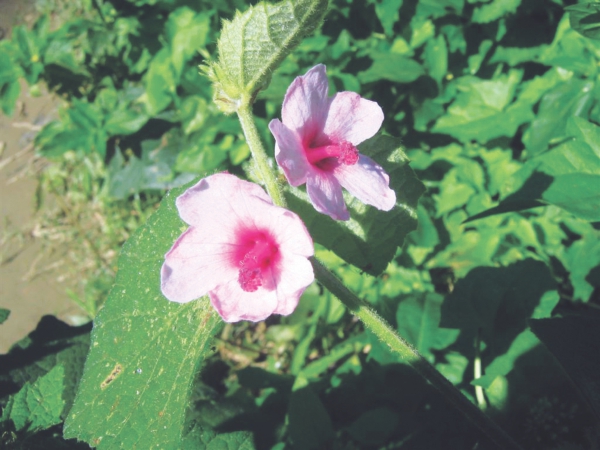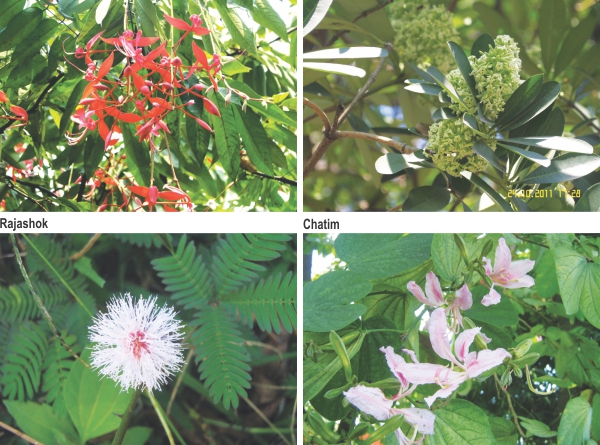| Home - Back Issues - The Team - Contact Us |
 |
| Volume 11 |Issue 45| November 16, 2012 | |
|
|
Nature
Autumn's Surreptitious Entrance Mokaram Hossain The arrival of late autumn is rather different and it is not very perceptible after the departure of autumn. That is why they say that 'late autumn comes on the sly'. The late autumn, however, is not altogether silent; we get to hear the sound of dews and the rustle of fallen leaves. The flutter of migratory birds are heard in the mildly chilly air. The age-old late autumn has remained evergreen. The sky becomes serene and clear. The nature is green all around. At places, a serpentine river flows through villages. The Kashbon (Saccharum sportaneum) fades away. The boatmen understand that the wild monsoon rivers will grow tame. Late autumn comes with its trademark component-- fog and it engulfs the surroundings right after the dusk. The morning sun will not daze your eyes. The dew-drenched late autumn night is also very pleasant. A careful look will show how fast things are changing around us. The flood water in the fields starts receding. The preparation for collecting date juice is underway. Bottle gourds are sown in the fallow lands. A variety of winter vegetables and crops fill us with joy. The green nature starts to change to yellow. The children get ready for outdoor sports. The morning rays of the sun is as sweet as the dew of the late autumn and it feels good to see such bright sunny days. Late autumn brings Nabanno (a festival to celebrate the harvest in late autumn). The farmers get busy harvesting paddy. The paddy will provide rice and rice powder for making cakes. The farmers' household will have a festive look then. They invite their near and dear ones to enjoy the new rice treats. This festival has been featured in the poems of many Bengali poets.
In the olden days husking rice was non -mechanised; a device called 'Dheki' was used for. It made a rhythmic noise which is no more heard. The poet of Ruposhi Bangla, Jibonananda Das is engrossed by late autumn, which is a recurring theme in his poems. 'Nabanno' is fairly an old festival in our culture. This festival, however, has lost much of its grandeur. Still, migratory birds come to this part of the world at the outset of autumn but the biggest crowd comes in the late autumn. The flutter of their wings wakes us up in the morning. When these birds fly in large flocks in the early morning or in the evening, they sound like storm. Though they stay for a short while in our country, they get pretty close to our hearts. Once they would ply fearlessly in our marshy lands, they don't feel safe these days because of the ruthless hunters. Migratory birds are a unique gift to our nature and we should do everything to ensure their safety. It is the late autumn that ushers the arrival of winter and the preparation for winter flower garden begins. Various seasonal flowers are sown in the garden. When the vegetation prepares to go into hibernation after shedding their leaves, a few flowers bloom as a saving grace of nature- they are not very visible though. Dharmara or Pitpatla (Stereospermum colais. Syn. S. personatum) blooms at the end of late autumn. To my knowledge, there are two such flowering trees in the Ramna Park of Dhaka. The trees are fairly tall with rectangular leaves. Yellowish flowers bloom at night and fall at dawn under the tree. The bottom of the flower is tubular; the front part is mike- shaped and they bloom for about a month. Another charming flower of the late autumn in 'Himjhuri' or 'Akashneem' (Millingtonia hortensis). The biggest tree can be found by the Science library of Dhaka University. There are a few trees in the Christian Graveyard by the Boldha Garden. The small tree in the garden of Shishu Academy has flowered three years ago. Akashneem (Millingtonia hortensis) is a fairly tall evergreen tree. The leaves are oval- shaped and green in colour. Flowers bloom in bunches in the branches. The flowers are white, tubular and sweet-scented. The star of five petals is set at the end of the tube, and there are five small anthers. This is also a nocturnal flower. The flower-bud remains dormant by the day. Debkanchon (Bauhinia purpurea), among a couple of Kanchan (flower) variety in our country, blooms in late autumn. The easiest way of identifying this tree is its joint leaves. The flowers are violet and fragrant. They have five long, unequal, petals. Chateem (Alstonia scholarlis), the traditional flower of Bengal, blooms in this season. The shape of this tree is attractive; equally attractive is its strong smell. They bloom in plenty. The off-white bunches of flowers intoxicates the air. Born without any care in the rural areas, these trees are not very common in the urban areas-only a few can be found in the parks or gardens. Colorful flowers of Rajashok (Amherstia nobilis) bloom in late autumn. The hanging flowers from the stem and branches look amazing. Lazzaboti (Mimosa pudica) and Bonokra (Urena lobata) bloom in the hilly regions. We have no idea about the whereabouts of this season. It visits us for a mere two months. We say goodbye to it in the Agrahayan and wait for its return.
|
||||
|
|||||

